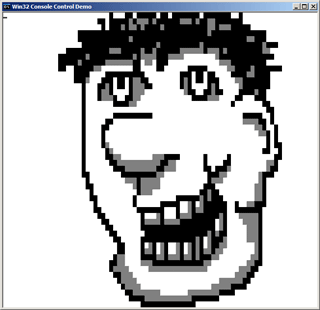Using the Keyboard, Mouse and Buffer
Here's an idea — let's see if we can create a simple painting program. We'll need to handle keyboard and mouse input, and will write to a buffer rather than directly to the console.
Firstly, we need to clear our drawing canvas. Where currently you fill the 80×50 CHAR_INFO buffer with random data, fill it instead with white-background spaces.
// Clear the CHAR_INFO buffer:
for (int i=0; i < 80 * 50; ++i) {
// Fill it with white-backgrounded spaces
consoleBuffer[i].Char.AsciiChar = ' ';
consoleBuffer[i].Attributes =
BACKGROUND_BLUE |
BACKGROUND_GREEN |
BACKGROUND_RED |
BACKGROUND_INTENSITY;
}
Well, that's easy enough. How can we draw to it? We need to handle mouse events. What we'll do is check to see if the left mouse button is held down, and if so we'll set the Char.AsciiChar of the corresponding CHAR_INFO in our consoleBuffer to something fitting — I rather like the solid block 0xDB. You might rather use the smiley faces!
To check for mouse buttons, you should use bitwise logic on the returned button status to mask out the button you are checking for. In our case, the following code is pretty good:
if (eventBuffer[i].EventType == KEY_EVENT) {
// Existing code to handle pressing Escape....
} else if (eventBuffer[i].EventType == MOUSE_EVENT) {
// Set the index to our buffer of CHAR_INFO
int offsetPos =
eventBuffer[i].Event.MouseEvent.dwMousePosition.X +
80 * eventBuffer[i].Event.MouseEvent.dwMousePosition.Y;
// Is it a left click?
if (eventBuffer[i].Event.MouseEvent.dwButtonState & FROM_LEFT_1ST_BUTTON_PRESSED) {
// Yep, so set with character 0xDB.
consoleBuffer[offsetPos].Char.AsciiChar = 0xDB;
// Redraw our buffer:
WriteConsoleOutputA(wHnd, consoleBuffer, charBufSize, characterPos, &writeArea);
}
}
In fact, I'm also going to make it write character 0xB1 if I right-click, so I can have a dithered effect, and middle-clicking will erase (set back to space). Pressing the letter 'c' on the keyboard will clear the "image" back to white. Here is the full source code for the console-based painting program:
#include <stdlib.h>
#include <stdio.h>
#include <Windows.h>
#include <Tchar.h>
HANDLE wHnd; // Handle to write to the console.
HANDLE rHnd; // Handle to read from the console.
int _tmain(int argc, _TCHAR* argv[]) {
// Set up the handles for reading/writing:
wHnd = GetStdHandle(STD_OUTPUT_HANDLE);
rHnd = GetStdHandle(STD_INPUT_HANDLE);
// Change the window title:
SetConsoleTitle(TEXT("Win32 Console Control Demo"));
// Set up the required window size:
SMALL_RECT windowSize = {0, 0, 79, 49};
// Change the console window size:
SetConsoleWindowInfo(wHnd, TRUE, &windowSize);
// Create a COORD to hold the buffer size:
COORD bufferSize = {80, 50};
// Change the internal buffer size:
SetConsoleScreenBufferSize(wHnd, bufferSize);
// Set up the character buffer:
CHAR_INFO consoleBuffer[80 * 50];
// Clear the CHAR_INFO buffer:
for (int i=0; i < 80 * 50; ++i) {
// Fill it with white-backgrounded spaces
consoleBuffer[i].Char.AsciiChar = ' ';
consoleBuffer[i].Attributes =
BACKGROUND_BLUE |
BACKGROUND_GREEN |
BACKGROUND_RED |
BACKGROUND_INTENSITY;
}
// Set up the positions:
COORD charBufSize = {80,50};
COORD characterPos = {0,0};
SMALL_RECT writeArea = {0,0,79,49};
// Copy to display:
WriteConsoleOutputA(wHnd, consoleBuffer, charBufSize, characterPos, &writeArea);
// How many events have happened?
DWORD numEvents = 0;
// How many events have we read from the console?
DWORD numEventsRead = 0;
// Boolean flag to state whether app is running or not.
bool appIsRunning = true;
// If we set appIsRunning to false, the program will end!
while (appIsRunning) {
// Find out how many console events have happened:
GetNumberOfConsoleInputEvents(rHnd, &numEvents);
// If it's not zero (something happened...)
if (numEvents != 0) {
// Create a buffer of that size to store the events
INPUT_RECORD *eventBuffer = new INPUT_RECORD[numEvents];
// Read the console events into that buffer, and save how
// many events have been read into numEventsRead.
ReadConsoleInput(rHnd, eventBuffer, numEvents, &numEventsRead);
// Now, cycle through all the events that have happened:
for (DWORD i = 0; i < numEventsRead; ++i) {
// Check the event type: was it a key?
if (eventBuffer[i].EventType == KEY_EVENT) {
// Yes! Was the key code the escape key?
if (eventBuffer[i].Event.KeyEvent.wVirtualKeyCode==VK_ESCAPE) {
// Yes, it was, so set the appIsRunning to false.
appIsRunning = false;
// Was if the 'c' key?
} else if (eventBuffer[i].Event.KeyEvent.uChar.AsciiChar=='c') {
// Yes, so clear the buffer to spaces:
for (int i = 0; i < 80 * 50; ++i) {
consoleBuffer[i].Char.AsciiChar = ' ';
}
// Redraw our buffer:
WriteConsoleOutputA(wHnd, consoleBuffer, charBufSize, characterPos, &writeArea);
}
} else if (eventBuffer[i].EventType == MOUSE_EVENT) {
// Set the index to our buffer of CHAR_INFO
int offsetPos =
eventBuffer[i].Event.MouseEvent.dwMousePosition.X
+ 80 * eventBuffer[i].Event.MouseEvent.dwMousePosition.Y;
// Is it a left click?
if (eventBuffer[i].Event.MouseEvent.dwButtonState & FROM_LEFT_1ST_BUTTON_PRESSED) {
// Yep, so set with character 0xDB (solid block)
consoleBuffer[offsetPos].Char.AsciiChar = (char)0xDB;
// Redraw our buffer:
WriteConsoleOutputA(wHnd, consoleBuffer, charBufSize, characterPos, &writeArea);
// Is it a right click?
} else if (eventBuffer[i].Event.MouseEvent.dwButtonState & RIGHTMOST_BUTTON_PRESSED) {
// Yep, so set with character 0xB1 (50% block)
consoleBuffer[offsetPos].Char.AsciiChar = (char)0xB1;
// Redraw our buffer:
WriteConsoleOutputA(wHnd, consoleBuffer, charBufSize, characterPos, &writeArea);
// Is it a middle click?
} else if (eventBuffer[i].Event.MouseEvent.dwButtonState & FROM_LEFT_2ND_BUTTON_PRESSED) {
// Yep, so set with character space.
consoleBuffer[offsetPos].Char.AsciiChar = ' ';
// Redraw our buffer:
WriteConsoleOutputA(wHnd, consoleBuffer, charBufSize, characterPos, &writeArea);
}
}
}
// Clean up our event buffer:
delete[] eventBuffer;
}
}
}
When run, you should be able to sketch away...

Bah, who needs Photoshop when you can create stunning self-portraits like the one above?